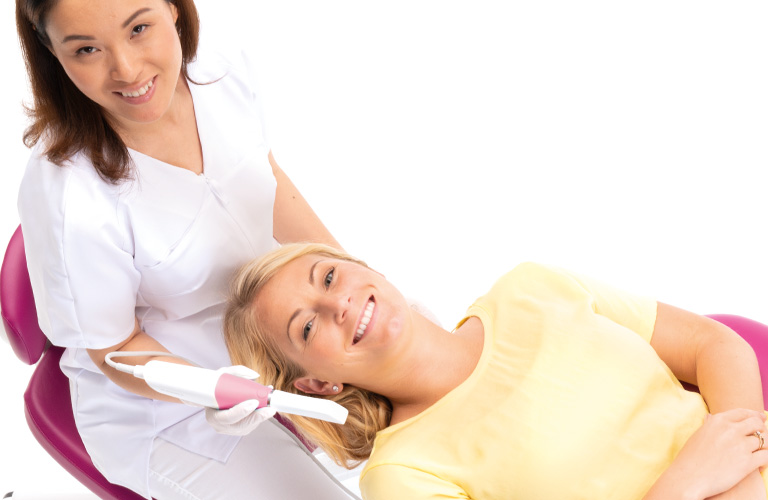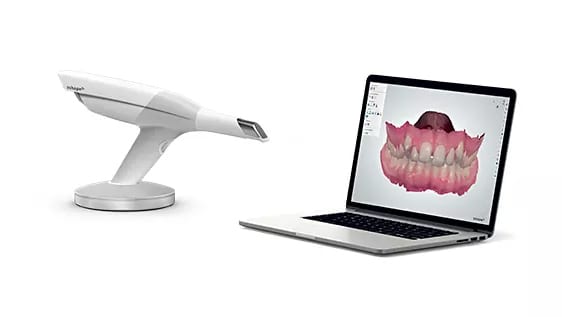Intraoral Fingerprint Scanner: what is it and how does it work?
Do you get the vomit reflex every time you get the impression?
Can't stand that terrible taste of the impression material?
Through this article, you will dive into the world of fingerprints, the new frontier of dentistry.

The first question that arises is: "why to use something digital?"
The answer is the same one that you would give yourself asking yourself why to use a smartphone, a computer, digital photography, or GPS. All of us, whether we like it or not, we are catapulted into the digital age.
Intraoral Fingerprint Scanner
Digital technology has changed the dental profession so radically that in the not too distant future, the art of taking conventional impressions will no longer be so necessary. In fact, spoons for fingerprints and related materials are increasingly being replaced, especially in the most advanced dental practices, by the use of the scanner.
Conventional Impressions vs. Intraoral Scanner
Normally, when a traditional impression is taken, the impression material is mixed in a cup and then distributed on a tray-shaped tray of a shape suitable for its arches. Subsequently, the impression tray with the material is inserted into the oral cavity of the patient and awaits hardening. Once the material has hardened, the impression is sent to the dental technician who will cast the plaster and study the case under the indications of the dentist.
The imprint that is detected with the traditional method is the negative of the oral cavity
When you look at a conventional impression, you see a negative image of the mouth. It is difficult if not sometimes impossible to accurately assess the quality of a footprint simply by evaluating its negative. Often there are bubbles, streaks, tears that can affect the accuracy of the procedure.
The fingerprint has improved this process and made it possible to evaluate the procedure in real-time. That is, by using an intraoral scanner equipped with a small camera, the dental arches are scanned so that they can be viewed in real-time on a computer monitor. In doing so, the problems of a traditional footprint are eliminated, namely:
You can see an enlarged high-resolution image of what the arch really is and not its negative; Allows the dentist to see the quality of the fingerprint while you are still in the chair; Any errors can be displayed on the monitor and immediately corrected.
The Intraoral Scanner is more precise and lasts even less

The dentist, thanks the fingerprint, receives an immediate verification of his work, avoiding additional appointments and new impressions. The fingerprint can be up to 20 minutes faster than conventional fingerprints, which results in significantly less stress for the patient.
Still, the need to keep the mouth open is minimal with fingerprints, since there is no impression material that leaks into the patient's mouth.
How do you take a fingerprint?
An intraoral scanner is a tool equipped with a camera that allows the acquisition of digital data. Without any kind of dust or liquid, the scanner detects the dental arches and scans them in a few minutes. After detecting the fingerprint, the data is transferred to software with which it will be possible to process and finalize the case.
The impression generated may be the same color as the patient's arches and may be shown to the latter, which will make it much easier to understand the rehabilitation that will be performed. Thanks to the fingerprint it is possible to make the prosthetic artifacts required in a precise, rapid, and comfortable way for the patient. In addition to prosthetic applications, fingerprints can even be used for orthodontic treatments.
Ultimately, fingerprints and intraoral scanners are taking over the conventional footprints. Although only 9% of the studies adopt this method, it is expected that most fingerprints will be digital in the future. In the next 5-10 years, it is estimated that the percentage will be close to 100%.
__________________________________________________________________________
Can't stand that terrible taste of the impression material?
Through this article, you will dive into the world of fingerprints, the new frontier of dentistry.

The first question that arises is: "why to use something digital?"
The answer is the same one that you would give yourself asking yourself why to use a smartphone, a computer, digital photography, or GPS. All of us, whether we like it or not, we are catapulted into the digital age.
Intraoral Fingerprint Scanner
Digital technology has changed the dental profession so radically that in the not too distant future, the art of taking conventional impressions will no longer be so necessary. In fact, spoons for fingerprints and related materials are increasingly being replaced, especially in the most advanced dental practices, by the use of the scanner.
Conventional Impressions vs. Intraoral Scanner
Normally, when a traditional impression is taken, the impression material is mixed in a cup and then distributed on a tray-shaped tray of a shape suitable for its arches. Subsequently, the impression tray with the material is inserted into the oral cavity of the patient and awaits hardening. Once the material has hardened, the impression is sent to the dental technician who will cast the plaster and study the case under the indications of the dentist.
The imprint that is detected with the traditional method is the negative of the oral cavity
When you look at a conventional impression, you see a negative image of the mouth. It is difficult if not sometimes impossible to accurately assess the quality of a footprint simply by evaluating its negative. Often there are bubbles, streaks, tears that can affect the accuracy of the procedure.
The fingerprint has improved this process and made it possible to evaluate the procedure in real-time. That is, by using an intraoral scanner equipped with a small camera, the dental arches are scanned so that they can be viewed in real-time on a computer monitor. In doing so, the problems of a traditional footprint are eliminated, namely:
You can see an enlarged high-resolution image of what the arch really is and not its negative; Allows the dentist to see the quality of the fingerprint while you are still in the chair; Any errors can be displayed on the monitor and immediately corrected.
The Intraoral Scanner is more precise and lasts even less

The dentist, thanks the fingerprint, receives an immediate verification of his work, avoiding additional appointments and new impressions. The fingerprint can be up to 20 minutes faster than conventional fingerprints, which results in significantly less stress for the patient.
Still, the need to keep the mouth open is minimal with fingerprints, since there is no impression material that leaks into the patient's mouth.
How do you take a fingerprint?
An intraoral scanner is a tool equipped with a camera that allows the acquisition of digital data. Without any kind of dust or liquid, the scanner detects the dental arches and scans them in a few minutes. After detecting the fingerprint, the data is transferred to software with which it will be possible to process and finalize the case.
The impression generated may be the same color as the patient's arches and may be shown to the latter, which will make it much easier to understand the rehabilitation that will be performed. Thanks to the fingerprint it is possible to make the prosthetic artifacts required in a precise, rapid, and comfortable way for the patient. In addition to prosthetic applications, fingerprints can even be used for orthodontic treatments.
Ultimately, fingerprints and intraoral scanners are taking over the conventional footprints. Although only 9% of the studies adopt this method, it is expected that most fingerprints will be digital in the future. In the next 5-10 years, it is estimated that the percentage will be close to 100%.
__________________________________________________________________________
___________________________________________________________________________
DISCLAIMER
Information brought to you by Massimo - Write me with your Panoramic X-Rays view for a free specialist diagnosis by sending an email to meditur@costaricabluezone.com
DISCLAIMER
The Content above even if the above information is written or supervised by a professional in dentistry. A physical examination is a procedure by which the dentists investigate the oral cavity of patients for signs of disease. -- Together with the medical history, the physical examination aids in determining the correct diagnosis and devising the treatment plan. -- Always seek the advice of your physician or other qualified health providers with any questions you may have regarding your medical condition



Comments
Post a Comment